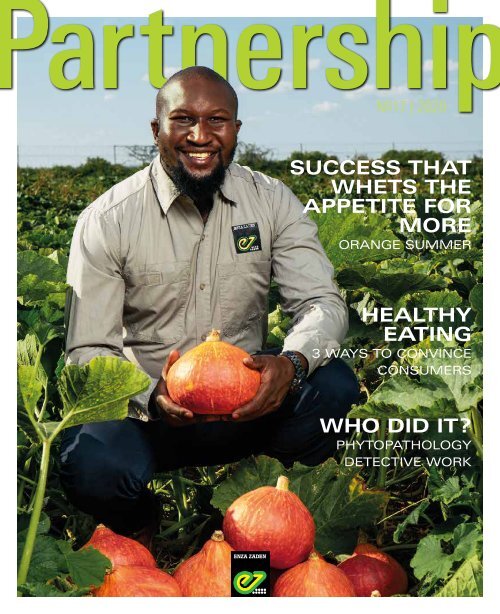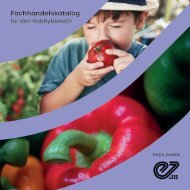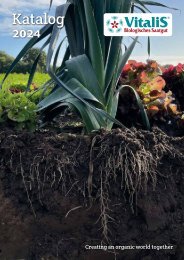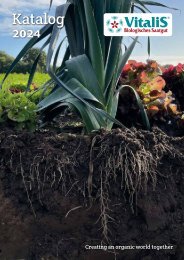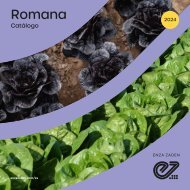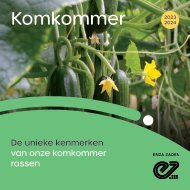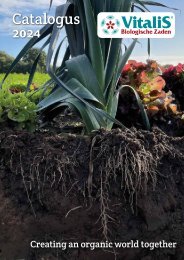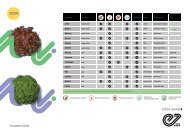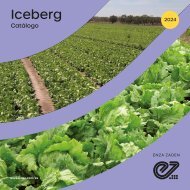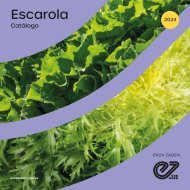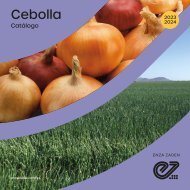The Partnership no. 17
Create successful ePaper yourself
Turn your PDF publications into a flip-book with our unique Google optimized e-Paper software.
N o <strong>17</strong> | 2020<br />
SUCCESS THAT<br />
WHETS THE<br />
APPETITE FOR<br />
MORE<br />
ORANGE SUMMER<br />
HEALTHY<br />
EATING<br />
3 WAYS TO CONVINCE<br />
CONSUMERS<br />
WHO DID IT?<br />
PHYTOPATHOLOGY<br />
DETECTIVE WORK
28<br />
Index<br />
Dear reader, dear partner,<br />
Welcome to the <strong>17</strong>th edition of the Enza Zaden ‘<strong>The</strong> <strong>Partnership</strong>’ magazine!<br />
In the current turbulent times, volatile<br />
markets and global work environment,<br />
we continue to work together with you to<br />
develop healthy vegetable varieties that<br />
excel in consistency, reliability and quality.<br />
In other words, varieties that you can rely<br />
on. This teamwork with you, at local and<br />
global level, is the key to our success.<br />
responsibility in terms of working<br />
conditions, as well as respect for the society<br />
and the environment. Enza Zaden is based<br />
on the principles of integrity, fairness and<br />
honesty, allowing us to represent your<br />
interest fairly. Furthermore, we adheres<br />
to the law, phytosanitary regulations and<br />
expects the same from our partners.<br />
4<br />
In<strong>no</strong>vation is the foundation and strength<br />
of Enza Zaden. We invest thirty percent of<br />
our tur<strong>no</strong>ver in research, broadening and<br />
developing the k<strong>no</strong>wledge of our employees<br />
and cooperation with our partners. And that<br />
pays off in the form of a constant flow of<br />
in<strong>no</strong>vations. Each week, we launch two new<br />
varieties onto the global market. Varieties<br />
that offer positive distinctive benefits and<br />
add value for our partners and customers.<br />
We will keep investing in the market,<br />
in<strong>no</strong>vation and products. However, we<br />
fully recognises we can only achieve this<br />
together with you to get the best outcome<br />
for all!<br />
Joost Gietelink<br />
Chief Financial Officer<br />
8<br />
16<br />
However, we can only reach this by working<br />
closely with all our partners and customers,<br />
globally and locally. <strong>The</strong>y come first: we<br />
try harder! We focus on serving the whole<br />
chain; from growers, traders, supermarkets<br />
and processing industry to consumers.<br />
Together we make the best quality products,<br />
for each product-market segment.<br />
22<br />
At these times, it also remains key for<br />
Enza Zaden to recognise our corporate<br />
responsibility, the importance of integrity<br />
and compliance with law. This affects our<br />
<strong>The</strong> <strong>Partnership</strong><br />
4<br />
Orange Summer’s success whets appetite for more<br />
A big hit in Europe: pumpkin variety Orange Summer. How<br />
this variety grew to become a game changer. And what it<br />
entailed.<br />
15<br />
In Focus<br />
Enza Zaden at the Fruit Logistica in Berlin. This year with<br />
two booths, because Tribelli® gets its own.<br />
24<br />
Inspiring marketing concepts<br />
Interesting developments take place in the way fresh herbs<br />
are offered for sale in European and North American<br />
supermarkets. Various sales concepts explained.<br />
8<br />
Quality gaining ground in the country of the Little<br />
Canaries One of the world’s biggest countries is<br />
undergoing a fundamental transition. Much has to do with<br />
the increased professionalism that’s still growing in Brazil.<br />
16<br />
Healthy eating<br />
From awareness to eating healthy. How? Three ways explained:<br />
encouraging, making the choice easy and helping<br />
consumers where k<strong>no</strong>wledge is needed.<br />
28<br />
High-tech Sherlock Holmes<br />
Did you k<strong>no</strong>w that phytopathologists and Sherlock Holmes<br />
have quite a bit in common when it comes to diag<strong>no</strong>stics?<br />
<strong>The</strong> work of lab detectives explained.<br />
12<br />
Premium varieties pay off<br />
Making a positive difference. That’s what the partnership<br />
between Filipi<strong>no</strong> onion grower Ramos and Enza Zaden is<br />
all about.<br />
20<br />
Compounds - beneficial for plants and people<br />
What’s good for plants, is often also beneficial for us humans.<br />
How compounds help plants and contribute to our<br />
health.<br />
31<br />
Continuous development and in<strong>no</strong>vation<br />
Polish trader Amplus is always looking for in<strong>no</strong>vations and<br />
opportunities. Being one of the largest enterprises in the Polish<br />
fresh produce market today, this approach clearly pays off.<br />
Cover: Matome Ramokgopa<br />
General Manager South Africa<br />
Commercial<br />
23<br />
Column<br />
Marc Vogels, Vice President Global Logistics, gives his<br />
vision on the global supply chain. And how cross functional<br />
teamwork leads to success.<br />
34<br />
Event calendar<br />
An overview of upcoming events.<br />
<strong>The</strong> <strong>Partnership</strong> | 3
Breeders pushing ahead<br />
with expanding range<br />
Product<br />
Orange Summer’s<br />
success whets<br />
appetite for more<br />
Pumpkin Orange Summer is a hit in Europe – and <strong>no</strong>t only in the summer and<br />
autumn. Now that this variety is also being grown for export in South Africa and New<br />
Zealand, it is available to consumers all year round. Meanwhile, a lot of effort is being<br />
put into expanding the market and breeders are building on future successes in this<br />
product segment. Team Pumpkin is making great headway.<br />
Pumpkins and squashes have been part of Enza Zaden’s<br />
portfolio ever since the company took over the Australian<br />
breeding company Yates in 2003. <strong>The</strong>se are a wide-ranging<br />
group of heirloom agricultural crops originating from Central and<br />
South America which includes both edible and <strong>no</strong>n-edible<br />
species. <strong>The</strong> main edible species are cultivars of Cucurbita<br />
maxima and moschata.<br />
“Around 15 years ago, the pumpkin and squash market was very<br />
modest in size,” Crop Research Director Ralf Kuijpers explains.<br />
“<strong>The</strong> range was dominated by landraces (locally adapted,<br />
traditional varieties) for organic cultivation. Nevertheless, we saw<br />
a lot of potential. <strong>The</strong> breeding programme started by Yates was<br />
expanded and linked to the activities of our subsidiary Vitalis,<br />
which specialises in the organic seed market.”<br />
Growth factors<br />
A number of factors formed the basis for the favourable market<br />
outlook. Demand for organically grown vegetables was steadily<br />
rising in western countries. This prompted supermarket chains<br />
to start looking at adding organic produce to their range. Being<br />
relatively easy to grow organically, pumpkins and squashes were<br />
an ideal way to meet both growers’ and consumers’ wishes.<br />
In parallel, organic cultivation was becoming more professional,<br />
and the demand for varieties that combined more predictable,<br />
high yields with uniform, flavoursome fruits with good keeping<br />
qualities increased.<br />
“This combination of factors is still the driving force behind the<br />
growing demand for hybrid pumpkin and squash varieties,”<br />
Kuijpers adds. “When we introduced Orange Summer F1 some<br />
years after the breeding programme was launched, the market<br />
was more or less completely ready for it.”<br />
4 | <strong>The</strong> <strong>Partnership</strong><br />
<strong>The</strong> <strong>Partnership</strong> | 5
Exceptional qualities<br />
To begin with, this market was limited to <strong>no</strong>rth-western Europe,<br />
starting in the Netherlands. <strong>The</strong>re, Orange Summer proved <strong>no</strong>t<br />
only that pumpkins were an excellent addition to organic product<br />
ranges but also that it had exceptional qualities compared with<br />
the main orange pumpkin variety grown at the time, Uchiki Kuri.<br />
Crop breeding manager Pauline Kerbiriou: “Orange Summer is an<br />
easy-to-grow, high-yielding variety that produces very uniform,<br />
flavoursome fruits. Because the plants are compact and easy to<br />
manage, it also takes a lot less time to keep the plot weed-free as<br />
you can use mechanical weed control for longer. That was – and<br />
is – a massive benefit for organic growers. It is also a reliable<br />
variety in the sense that it copes well with changing growing<br />
conditions and is <strong>no</strong>t particularly susceptible to diseases.”<br />
Widespread interest<br />
Because of its versatility and the growing popularity of pumpkins<br />
and squashes among consumers and both organic and<br />
conventional growers, Orange Summer soon found its way into<br />
other countries such as Germany, France and Poland. And that<br />
growth looks set to continue.<br />
“Pumpkins and squashes are once again enjoying great popularity<br />
as versatile vegetables that respond perfectly to the healthy eating<br />
trend and the growing demand for authentic products,” says<br />
Kerbiriou. “In Europe, you can definitely call Orange Summer the<br />
leader of the pack.”<br />
However, its enthusiastic reception also caused a problem: it<br />
has a relatively short season. In Europe, pumpkins and squashes<br />
are a typical seasonal product, available in summer and autumn<br />
only. Once Orange Summer had made its mark on all fronts over<br />
several years, consumers, retailers and wholesalers wanted it to<br />
be available at other times of the year as well.<br />
Opposite seasons<br />
<strong>The</strong> answer lay in South Africa. With opposite seasons to<br />
Europe, this country offered opportunities to grow the variety<br />
there specifically for the European market.<br />
“Until recently, there was virtually <strong>no</strong> demand for orange<br />
pumpkins in South Africa,” Matome Ramokgopa, General<br />
Manager of Enza Zaden South Africa, explains. “It’s the grey<br />
pumpkin that dominates here. So working with a local grower<br />
and a Dutch importer, we started producing Orange Summer<br />
on a small scale here in 2015. <strong>The</strong> trial was a great success.<br />
We currently supply seed to around 20 farmers, who are growing<br />
several hundred hectares of the variety this season. Also, our<br />
production period lasts much longer than in Europe; due to the<br />
differences in climate zones and altitude, we can cultivate these<br />
pumpkins almost all year round.”<br />
<strong>The</strong> fruits are shipped to Rotterdam from Cape Town in<br />
climate-controlled sea containers. From there, a select group<br />
of dedicated importers sends them out to distributors, retailers<br />
and consumers right across <strong>no</strong>rth-western Europe.<br />
Although South Africans themselves haven’t yet developed a<br />
taste for the orange pumpkin, the market there is also changing.<br />
<strong>The</strong> growing area for grey pumpkins, which dominated the<br />
market for many decades, is gradually diminishing in favour of<br />
the butternut squash, the dominant type of squash in North<br />
America. But Ramokgopa expects orange pumpkins to increase<br />
in popularity too. “Our most successful variety and some recent<br />
introductions have so many good qualities that the consumer will<br />
ultimately welcome them,” he adds confidently.<br />
New Zealand is also latching on to the trend with an increasing<br />
growing area for various pumpkins and squashes, predominantly<br />
cultivated for export to Japan and Europe.<br />
Product<br />
“We can cultivate<br />
these pumpkins almost<br />
all year round.”<br />
Matome Ramokgopa<br />
6 | <strong>The</strong> <strong>Partnership</strong><br />
Two teams in four countries<br />
To date, <strong>no</strong> other pumpkin hybrid has come anywhere close<br />
to Orange Summer’s success. However, pumpkin and squash<br />
breeders in New Zealand, Australia, the Netherlands, France,<br />
India and Malaysia have been working hard on expanding<br />
Enza Zaden’s portfolio.<br />
“My colleagues in Malaysia and India are working on new<br />
varieties exclusively for the tropics and subtropics,” Kerbiriou<br />
explains. “<strong>The</strong>y are mainly using other types and genetic lines<br />
than my colleague in Europe and I are. So you could actually<br />
describe us as two specialist breeding teams. But we still<br />
exchange k<strong>no</strong>wledge and genetic material with each other, for<br />
instance for crossing backwards and forwards to improve<br />
resistance traits. And that’s the nice thing about working for<br />
this company: Enza Zaden has such a wide-ranging pumpkin<br />
and squash programme that you can in<strong>no</strong>vate on many different<br />
fronts, including interspecific crossings.”<br />
Portfolio under development<br />
It is therefore hardly surprising that several new varieties have<br />
been introduced in recent years. In the orange pumpkin segment,<br />
the late, long-lasting variety Kauri Kuri is an excellent addition to<br />
Orange Summer, with longer storability. Bright Summer is a<strong>no</strong>ther<br />
very recent introduction.<br />
<strong>The</strong> butternut squash is the world’s most widely grown and eaten<br />
type, and there is a wide choice of colours, shapes, sizes and<br />
flavours, many of which are combined with disease resistance<br />
or tolerance. “Local growing conditions and preferences dictate<br />
what specific combinations of traits are wanted,” the Senior<br />
Breeder explains. “With Havana, Jaqueline, Matilda and Tiana,<br />
for instance, we have a number of promising varieties for<br />
Matome Ramokgopa.<br />
very different markets.” As yet there are <strong>no</strong> breakthroughs to<br />
report in the Kabocha squash segment, which is very popular<br />
in Japan, but this could also change over the next few years.<br />
Kerbiriou: “<strong>The</strong> Japanese are the most critical consumers in the<br />
world. Kabochas are closely related to the orange pumpkin but<br />
they have a higher dry matter content, more sugar and a more<br />
intense flavour. For that reason, they are also becoming more<br />
popular in Europe and North America. So we are working hard<br />
to produce varieties in this segment that can match up to the<br />
best. I have every confidence that we will be able to meet<br />
this challenge.”<br />
Game changer<br />
Ralf Kuijpers agrees. “<strong>The</strong> success of Orange Summer certainly<br />
whets your appetite for more, but these game changers are<br />
extremely rare,” he admits. “Despite that, we have a large team<br />
of highly competent people working specifically on this<br />
segment. I don’t k<strong>no</strong>w of any other breeding company that has<br />
such a broad and geographically wide spread pumpkin and<br />
squash programme. And we need that, so that we can continue<br />
to offer growers and consumers the best possible products –<br />
wherever they are.”<br />
<strong>The</strong> <strong>Partnership</strong> | 7
Markets<br />
With a surface area of<br />
8.5 million square kilometres,<br />
Brazil is the fifth largest<br />
Quality<br />
country on earth.<br />
gaining<br />
ground<br />
in the country of the<br />
Little Canaries<br />
Brazil is big and something of a challenge in many respects. That’s <strong>no</strong> less true of<br />
the vegetables sector, which is undergoing a fundamental transition. Enza Zaden<br />
opened a commercial office in Holambra ten years ago, followed in 20<strong>17</strong> by<br />
the opening of their breeding station. A growing number of modern varieties<br />
with added value are <strong>no</strong>w finding their way to grower, retailer and consumer.<br />
With a surface area of 8.5 million square kilometres, Brazil is<br />
the fifth largest country on earth. Its more than 210 million<br />
inhabitants form a melting pot of cultures and eating habits from<br />
both the old and new worlds. <strong>The</strong> agricultural sector, which<br />
accounts for a third of the country’s gross national product, is<br />
undergoing a phase of rapid professionalisation coupled with<br />
investments in modern tech<strong>no</strong>logy and quality assurance.<br />
“Consumers and supermarkets want more choice and are<br />
specifically demanding quality guarantees,” explains Jean-<br />
François Hardouin, General Manager Enza Zaden Brazil. “From<br />
2020, traceability will be required by law. This has a significant<br />
impact on the whole of the production and supply chain.”<br />
General Manager Enza Zaden Brazil Jean-François Hardouin:<br />
"Consumers and supermarkets want more choice and are specifically demanding quality quarantees."<br />
“This puts significant pressure on primary producers,” says<br />
Region Manager South & Central America Geale Sevenster.<br />
“Putting certified quality assurance systems in place leads to<br />
other decisions and working methods, including in terms of crop<br />
protection and company hygiene. Growers are having to keep<br />
detailed administrative records and crop registration and are<br />
focusing more on working conditions. This is taking some getting<br />
used to, especially for smaller producers.”<br />
Both men agree that this professionalisation process has been<br />
going on for some years <strong>no</strong>w. Among other things, it has led<br />
to more direct contact between supermarkets’ purchasing<br />
departments and both mi<strong>no</strong>r and major producers.<br />
Rapid professionalisation<br />
Traceability means that it must be possible to show at any time<br />
where, when, by whom and how all fresh produce offered on<br />
the market was grown and the route it took in the supply chain.<br />
<strong>The</strong> same obligation applies to starting material such as<br />
vegetable seed.<br />
Protected cultivation on the rise<br />
As a result of the more stringent quality requirements and the<br />
demand for more variety and choice in the produce offered,<br />
protected cultivation is on the rise. Perhaps <strong>no</strong>t as quickly as we<br />
would like, but this is <strong>no</strong>netheless a positive development for<br />
various reasons. By investing in greenhouses – particularly plastic<br />
8 | <strong>The</strong> <strong>Partnership</strong><br />
<strong>The</strong> <strong>Partnership</strong> | 9
ones – and polytunnels, producers can grow more high-quality<br />
crops and specialities produce at home, like tomato, sweet pepper<br />
and lettuce. This puts products that are less successful in<br />
open field production within reach and makes offerings more<br />
predictable due to the decreasing influence of weather conditions.<br />
Fewer formalities<br />
Hardouin and Sevenster are keen to see this development<br />
continue. That’s <strong>no</strong>t easy, because loans are expensive. What’s<br />
more, importing advanced cultivation tech<strong>no</strong>logy is very<br />
complicated. “Brazil is a wonderful country full of opportunities<br />
for entrepreneurs, but it also has a massive and complicated<br />
bureaucracy,” the general manager says. “We also have to<br />
contend with it, in the form of time-consuming procedures and<br />
formalities.”<br />
Region manager Sevenster adds: “A global company like ours<br />
benefits from a liberal trade environment. Ultimately that’s also<br />
better for our customers, who want access to the best varieties<br />
as quickly and eco<strong>no</strong>mically as possible. Having fewer formalities<br />
at the border is also good for international fresh produce chains.<br />
Fresh produce has a limited shelf life, and efficient chains go a<br />
long way towards reducing the substantial food losses.”<br />
Diverse eating cultures<br />
At present, the demand for new, often relatively expensive<br />
vegetables is limited to the wealthier parts of the population living<br />
in and around the cities. <strong>The</strong> vast interior and rural areas are both<br />
more thinly populated and less well off. On top of that, the longer<br />
logistics lines impact on product shelf life.<br />
“As far as their eating habits are concerned, Brazilian consumers<br />
are <strong>no</strong>t the most adventurous,” Hardouin remarks. “<strong>The</strong> other side<br />
of the coin is that there are a range of cultural niches in this<br />
country stemming from its rich legacy of immigration. Besides<br />
strong Portuguese and African influences, there are also Italian,<br />
German and Japanese strands, for example. All these also offer<br />
opportunities for extending the product range. And these days,<br />
the younger generation in particular are discovering new<br />
cooking styles, dishes and ingredients much more quickly and<br />
more intensively through travel and social media. All things<br />
considered, therefore, there is plenty of fertile ground for new<br />
market launches.”<br />
Demand for resistant varieties<br />
Growers also have their wish lists. <strong>The</strong>re is a great demand for<br />
varieties with more resilience or resistance to major pests and<br />
diseases. Sevenster: “This demand is <strong>no</strong>thing new, of course,<br />
but it is also being boosted by restrictions on chemical crop<br />
protection products and the general desire to make agricultural<br />
production systems more sustainable. Understandably, breeding<br />
companies are paying a lot of attention to this.”<br />
Resistance delivers clear added value for growers. Among the<br />
varieties Enza Zaden Brazil has successfully launched - partially<br />
thanks to their resistance properties - are Bremia resistant iceberg<br />
lettuce Ludmilla, the pink root resilient onion variety Rachelle<br />
(5605) and the tomato PaiPai, which combines resistance to<br />
spotted wilt with excellent yields. Other successful introductions<br />
are the cherry tomato Bosco and the cantaloupe-type melon<br />
Konquista.<br />
“Melons are a major export product for Brazil and account for<br />
a large growing area,” Hardouin adds. “Konquista produces a<br />
strong crop and very flavoursome fruits with a long shelf life.<br />
It has really put the company on the map in this segment.<br />
Hopefully we’re able to continue to build on this position with<br />
additional introductions, including in other types of melons.”<br />
Breeding for the tropics<br />
However, these won’t be coming out of the R&D kitchen at<br />
the Holambra breeding station any time soon. <strong>The</strong> team of 15<br />
dedicated breeding and selection specialists is focusing primarily<br />
on tomato, sweet pepper and leafy vegetables. “<strong>The</strong>ir efforts <strong>no</strong>t<br />
only benefit the substantial domestic market,” Sevenster points<br />
out. “Enza Zaden carries out breeding work at various places in<br />
different climate zones. Each station has its own portfolio of crops<br />
and breeding objectives centred around aspects such as climate,<br />
cultivation methods and, of course, consumer preferences.<br />
We also have several breeding sites in the tropics and subtropics.<br />
Holambra may have a limited crop portfolio, but it is leading the<br />
way for future in<strong>no</strong>vations in all countries with similar climatic<br />
and growing conditions.<br />
Markets<br />
Long-term relationships<br />
Brazilian growers generally place<br />
great value on long-term<br />
relationships with their suppliers.<br />
Designated contact persons with an<br />
in-depth k<strong>no</strong>wledge of the market, the<br />
product and the customer’s business<br />
are highly valued but very scarce.<br />
“In this country it’s quite rare to spend<br />
your entire working life at the same<br />
company,” says Jean-François<br />
Hardouin, General Manager of<br />
Enza Zaden Brazil.<br />
“If a Brazilian gets tired of their job,<br />
if they could earn more somewhere<br />
else, or even if they just don’t feel<br />
like doing it anymore, they will<br />
quite happily resign. Let’s say it’s<br />
just part of the culture. But employee<br />
tur<strong>no</strong>ver at Enza Zaden is exceptionally<br />
low. I think this has to do with the<br />
nature of a well-managed family<br />
business that is used to investing in<br />
its people. It’s quite remarkable that<br />
we have been able to sustain this<br />
after decades of strong growth and<br />
internationalisation. It’s also very<br />
positive, because a stable foundation<br />
enables you to build stronger houses.”<br />
Its more than 210 million<br />
inhabitants form a melting pot of<br />
cultures and eating habits from<br />
both the old and new worlds.<br />
“Brazil is a wonderful<br />
country full of opportunities<br />
for entrepreneurs.”<br />
Jean-François Hardouin<br />
10 | <strong>The</strong> <strong>Partnership</strong><br />
<strong>The</strong> <strong>Partnership</strong> | 11
Premium varieties pay off<br />
<strong>Partnership</strong><br />
G<br />
d<br />
news<br />
for Filipi<strong>no</strong><br />
onion growers<br />
One of the keys to a successful business is<br />
to keep in<strong>no</strong>vating and developing products<br />
that meet the needs of growers and the<br />
market. This is something Enza Zaden k<strong>no</strong>ws<br />
all about. <strong>The</strong> company introduces premium<br />
quality vegetable varieties every year through<br />
its many distributors and subsidiaries. One<br />
of which is the subsidiary in the Philippines,<br />
established at the end of 2018.<br />
Reynaldo C. Ramos is the first Filipi<strong>no</strong> farmer to grow the red<br />
onion variety Malbec, and he is delighted with the results.<br />
In April 2019, he managed to produce a staggering 168 tons of<br />
onion from his 3.5 hectare plot. “I used to yield only around<br />
84 tons on the same field,” says Reynaldo, who has been<br />
growing onions since 1992. Malbec produced double the amount<br />
compared to other varieties. And that’s why he <strong>no</strong>w plans to<br />
expand his Malbec production area from 3.5 to 5 hectares in 2020.<br />
Increased profits<br />
Higher yields mean higher revenue. So, Reynaldo earns twice as<br />
much from the red onion variety. Malbec’s other distinguishing<br />
characteristics include a large bulb and a so-called double bulb<br />
skin, which, according to Reynaldo, is just what buyers want.<br />
<strong>The</strong> thick skin protects the bulb from damage so that its quality is<br />
maintained all the way to the end user.<br />
12 | <strong>The</strong> <strong>Partnership</strong><br />
<strong>The</strong> <strong>Partnership</strong> | 13
<strong>The</strong> most important thing is that Filipi<strong>no</strong>s like the Malbec-style<br />
red onion. Since the market for Malbec has been established,<br />
Reynaldo and other Malbec farmers can still make a profit when<br />
the price of fresh onion falls. And they can make an even better<br />
return when the price of fresh onion is at its highest.<br />
Increased crop area<br />
Given all these advantages, Reynaldo is certain that Malbec is<br />
the best red onion variety in the Philippines. “Malbec fulfils all<br />
the criteria for a superior onion. It is early maturing, with a<br />
large bulb and high yield,” says Reynaldo, who was introduced<br />
to Malbec by his friend and happens to be an Enza Zaden<br />
Philippines distributor.<br />
Reynaldo likes to explore new tech<strong>no</strong>logies and new varieties.<br />
That is why he readily accepted Malbec, even though it was a new<br />
onion in the Philippines at that time. He is also the kind of person<br />
who likes to help others. He is happy to praise the virtues of<br />
Malbec and share his experience of growing it with fellow<br />
farmers. “I want other farmers to reap the benefits of cultivating<br />
Malbec too,” says the 51-year-old. And slowly but surely, other<br />
onion producers are making the same switch.<br />
According to Reynaldo, about twenty growers are currently<br />
cultivating Malbec on the Philippines. <strong>The</strong> total crop area has<br />
increased from the original 3.5 to more than 25 hectares: “I am<br />
delighted that the total area under cultivation has increased to this<br />
extent, considering the Malbec was first marketed in late 2018,”<br />
says Edicer Ocampo, Enza Zaden Philippines head of sales.<br />
14 | <strong>The</strong> <strong>Partnership</strong><br />
“Malbec<br />
fulfils all the<br />
criteria<br />
for a superior<br />
onion.”<br />
Reynaldo C. Ramos<br />
Mutual cooperation<br />
Clearly the new onion variety is becoming increasingly popular<br />
with Filipi<strong>no</strong> farmers, especially in the village of Antipolo in the<br />
Nueva Ecija province, where Reynaldo’s land is located. <strong>The</strong><br />
province is the leading producer of onions in the country, and<br />
Reynaldo is one of the most influential farmers in the area. In<br />
addition to onions, Reynaldo also produces pumpkins, tomatoes<br />
and chilies. He plans to use Enza Zaden varieties for these three<br />
crops as well. “We have decided to make him our brand<br />
ambassador in recognition of his efforts in endorsing the<br />
benefits of Malbec among other farmers,” says Edicer. “This<br />
further solidified our good business relationship. We are pleased<br />
to have Reynaldo as our brand ambassador, k<strong>no</strong>wing his capacity<br />
for promoting Malbec. We hope Malbec will become the farmers’<br />
choice of onion.”<br />
And Reynaldo has discovered that there are some perks to being<br />
the brand ambassador: he gets to be the first to grow the new<br />
crops and latest varieties. To ensure production runs smoothly,<br />
Enza Zaden has reliable field officers who are always ready to give<br />
technical assistance to their farmers.<br />
You could say that Reynaldo and Enza Zaden are like two sides<br />
of a coin. Reynaldo hopes to increase his profits by using quality<br />
products from Enza Zaden while Enza Zaden is eager to in<strong>no</strong>vate<br />
in order to develop varieties and produce seed that meets the<br />
needs of local farmers.<br />
We create<br />
value for you<br />
People at Enza Zaden are continuously working to develop<br />
the best vegetable varieties. However, the best variety for<br />
one customer is <strong>no</strong>t necessarily right for everyone. What’s<br />
important is developing varieties to meet our customers<br />
aspiration to deliver a point of difference in their market.<br />
We do this through the development of varieties that offer<br />
added value and match the strategy of our customers<br />
throughout the chain.<br />
Customer first<br />
This means putting our customers first. Focusing our efforts<br />
to understand their total business and its environment.<br />
Together we constantly ask the question: ‘How can we create<br />
added value?’ This all revolves around building and maintaining<br />
an interactive personal relationship. It begins with companies,<br />
it evolves with people!<br />
Common challenge<br />
We accept the objectives of our customers as a common<br />
challenge. We use all our skills and k<strong>no</strong>w-how at all levels<br />
to achieve those objectives. That way we all win. From our<br />
customers to the final consumer, we are all succeeding.<br />
Do you want to k<strong>no</strong>w how we can<br />
create value for you? Let’s meet at Fruit<br />
Logistica Berlin!<br />
Let’s meet<br />
Fruit Logistica Berlin<br />
5-7 February 2020<br />
Hall 1.2 | Booth C-07<br />
It's all about<br />
flavour<br />
Last June, Tribelli® has been awarded with<br />
the Superior Taste Award, celebrated by<br />
the International Taste Institute in Brussels.<br />
<strong>The</strong> <strong>Partnership</strong> | 15<br />
In Focus
Trends<br />
From awareness<br />
to action!<br />
<strong>The</strong> fact that a good diet plays an important role in good health is <strong>no</strong>thing<br />
new. And <strong>no</strong>r is raising awareness of this among consumers. What<br />
is new is that more and more initiatives are being launched to help people<br />
make conscious choices when it comes to healthy eating.<br />
Healthy eating<br />
Time and again, research shows that a healthy diet can improve<br />
the quality of life and can even help prevent certain diseases.<br />
But with the growing availability of cheap, highly processed<br />
ready meals in recent decades, the healthy choice is <strong>no</strong> longer<br />
naturally made. We have lost the balance between refined food<br />
and unrefined natural products that still contain a full range of<br />
vitamins and minerals. How do you convince the general, healthy<br />
public to eat more vegetables, one of the main components in a<br />
healthy diet? According to marketing experts Anne-Marie Roerink<br />
and Hans Verwegen, there are three ways to do this: encourage<br />
people to buy vegetables, make this an easy choice for them, and<br />
offer help where the k<strong>no</strong>wledge needed to make that choice is<br />
lacking.<br />
Encouraging people to buy vegetables with<br />
discounts and incentives<br />
Healthcare costs are sky-rocketing. So it’s hardly surprising<br />
that insurance companies are coming up with ways to get their<br />
customers to adopt a healthier lifestyle as a way of preventing ill<br />
health later in life. “Some American health insurance companies<br />
are working with businesses to offer discounts or incentives to<br />
people who don’t smoke or have quitted, who get vaccinated,<br />
or who follow a special diet such as Weight Watchers,”<br />
Anne-Marie Roerink of US company '210 Analytics' explains.<br />
“<strong>The</strong>y also encourage people to eat healthily: for example, by<br />
offering a discount if you have eaten a variety of different-coloured<br />
fruit and vegetables every day. <strong>The</strong>y have a special system for this<br />
which you have to log into to record what you have eaten.”<br />
Insurance companies in the Netherlands (Europe?) are also doing<br />
their bit by incentivising special diets designed to reverse the<br />
adverse effects of certain diseases, such as type 2 diabetes, but<br />
also Crohn’s disease and arthritis.<br />
On the shop floor<br />
Supermarkets are also latching onto this trend in a big way,<br />
with more and clearer information on packaging, healthy<br />
convenience products and special shelves in stores to help<br />
influence consumers’ decision-making processes. This is often<br />
referred to as nudging.<br />
And it has been shown to work. A joint experiment was set up<br />
by the Netherlands Nutrition Centre, the industry association<br />
and researchers to investigate the extent to which the in-store<br />
environment influences consumers’ food choices. A supermarket<br />
branch was converted for six weeks into a ‘Go For Colour Lab’<br />
in which fruit and vegetables were given a more prominent<br />
position by making subtle changes to the in-store environment.<br />
<strong>The</strong> nudges ranged from access gates and shopping cart inlays to<br />
healthy options at the checkouts. After analising the sales figures<br />
from the control supermarket, it was found that even little nudges<br />
made it easier for people to make healthy choices. Bearing in<br />
mind that research has shown that we make around two hundred<br />
food choices every day – mostly impulsively, automatically and<br />
subconsciously – it is clear that there is a wealth of opportunities<br />
to positively impact people’s healthy eating behaviour by nudging.<br />
16 | <strong>The</strong> <strong>Partnership</strong><br />
<strong>The</strong> <strong>Partnership</strong> | <strong>17</strong>
Learning to cook<br />
with fresh packs<br />
In 2015, Bakker Barendrecht - a Dutch service provider<br />
for fresh fruit and vegetables - won the third prize in the<br />
annual Fruit Logistica In<strong>no</strong>vation Awards in Berlin for its<br />
DIY Fresh Packs – complete packs of fresh ingredients<br />
containing everything you need plus a simple recipe.<br />
Rarely has an award winner become such an overnight<br />
success. This ready-to-make healthy solution was a<br />
huge hit in the Netherlands in both the vegetable-based<br />
soups and meals categories. <strong>The</strong> themed structure with<br />
the emphasis on foreign cuisines is a striking element.<br />
<strong>The</strong> dishes are adventurous and many are suitable for<br />
vegetarians. In this way, young people are gradually<br />
learning to cook again – with the added bonus of a slightly<br />
broader world view than their grandmothers!<br />
18 | <strong>The</strong> <strong>Partnership</strong><br />
Product triggers to make choices easier<br />
Supermarkets are also doing their bit to entice consumers to buy<br />
more fresh ingredients. <strong>The</strong>se days, fresh produce shelves are<br />
brimming with low-threshold convenience packs to prompt the<br />
consumer to make healthy choices. Bags of pre-cut butternut<br />
squash wedges, bags of mixed pre-chopped vegetables or<br />
ready-to-eat salads: all initiatives designed to help consumers<br />
buy healthy food without compromising on convenience. "This<br />
is partly due to the fact that we are living such busy urban lives,"<br />
says Marketing Analyst Hans Verwegen. “Everyone is busy;<br />
people don’t have time to stand in the kitchen chopping and<br />
cooking. Add to that the fact that everyone in a family has their<br />
own agenda and sitting down for a meal together has long ceased<br />
to be an natural part of the day. A wide range of pre-cut veggies<br />
and vegetable mixes responds perfectly to this.”<br />
Fresh packs<br />
<strong>The</strong> DIY Fresh Packs sold in Dutch supermarkets, which were<br />
<strong>no</strong>minated for the Fruit Logistica In<strong>no</strong>vation Award in 2015, fit<br />
into this picture – even if they take a little more time to prepare.<br />
This response by food retailers to the meal boxes from companies<br />
like Hello Fresh has become a major success in a short amount<br />
of time. This is also reflected in the decline of Dutch sales of<br />
so-called 'world dishes' with only dried ingredients in a small<br />
box. Verwegen: “People are <strong>no</strong>w wanting to get more enjoyment<br />
out of food and experience real flavours. <strong>The</strong>se fresh packs,<br />
which come with all the fresh vegetables, fruit, herbs and spices<br />
and whatever else you need to make a dish, fit in well with this<br />
trend. All you have to do is add meat or fish if you want to go<br />
for a <strong>no</strong>n-vegetarian version. Of course, you still have to chop<br />
the ingredients yourself, but you’re cooking yourself, the recipe<br />
is easy and you can give it your own twist. <strong>The</strong> whole process<br />
is satisfying, healthy and still easy. <strong>The</strong> concept is particularly<br />
popular with millennials who like cooking with fresh, healthy<br />
ingredients.”<br />
Challenges<br />
Both triggers bring with them new challenges for breeders, such<br />
as developing varieties that are easy to cut and have a long shelf<br />
life once cut, and smaller sized vegetables for the fresh packs.<br />
“A large cauliflower or squash just won’t fit in the box. Also, there<br />
are combinations of different vegetables in these packs, so you<br />
just don’t need such big products. <strong>The</strong> ingredients in the packs<br />
are in exactly the right quantities, so there’s <strong>no</strong> waste. But we<br />
need to do more if we want to attract the consumers’ attention<br />
continuously. Think of good flavours, pleasant textures and<br />
attractive colours.”<br />
Help choosing<br />
Healthy eating often starts in the supermarket. Stores with their<br />
own in-house dietitians are <strong>no</strong> exception these days in North<br />
American supermarkets. <strong>The</strong>y walk through the store with the<br />
consumer and help them decide what to buy and eat. Thanks to<br />
these retail dietitians, consumers can match what they eat ever<br />
more closely to their own personal wants and needs.<br />
<strong>The</strong> initiative for this stems from an American study in which<br />
dietitians accompanied patients with high blood pressure on<br />
shopping trips. <strong>The</strong> result was that these consumers started<br />
eating more fruit and vegetables, legumes, whole grains and<br />
unsaturated fats and cut down on saturated fats and salt.<br />
Roerink: “Nowadays more and more supermarket chains have<br />
fully qualified dietitians walking round to give customers advice<br />
on their health situations and lifestyles. <strong>The</strong>y provide nutritional<br />
advice, develop recipes and guide customers round the aisles, for<br />
example to inform consumers with type 2 diabetes what they can<br />
eat, what items are good substitutes, and so on. It’s a really great<br />
system for highlighting the elements of a healthy diet and giving<br />
practical tips on how to follow it.”<br />
Diabetes reversed with healthy diet<br />
Arie Derksen started taking medication for type 2 diabetes<br />
twenty years ago. And in <strong>no</strong> small way, either: he was ultimately<br />
injecting 64 units of insulin to get himself through the day. His<br />
GP recommended a special programme which he could follow to<br />
reverse the effects of his disease. His health insurance covered<br />
the costs for the “Keer Diabetes2 Om” (Reverse Type 2 Diabetes)<br />
programme in which a specialist team consisting of a doctor, a<br />
dietitian, a diabetic nurse and a mental coach helped him change<br />
his lifestyle.<br />
Arie: “It wasn’t a difficult choice. Eighty-eight percent of<br />
participants were able to cut down on their medication and were<br />
Personalised food<br />
All this is just a step up to the next big thing in health trends.<br />
<strong>The</strong> obvious next stage is that, bit by bit, all the initiatives to<br />
encourage ideal eating habits will be geared precisely to each<br />
consumer’s personal situation. Advances have already been made<br />
in this trend towards personalised food in the US, but we are also<br />
seeing cautious signs of this in other western countries.<br />
fitter and healthier after two years. I wanted that too. <strong>The</strong> team<br />
gave me a lot of advice on diet, exercise and stress. <strong>The</strong>re even<br />
were cookery workshops where I learned how to cook<br />
low-carbohydrate meals.”<br />
Completely transformed<br />
<strong>The</strong> end result is spectacular. Just three months after starting the<br />
programme, Arie has stopped taking his medication, lost a good<br />
15 kg in weight and is 15 cm slimmer around the waist. “If you<br />
had told me that would happen before I started, I would have said<br />
you were crazy. This programme has changed my life. I feel fitter<br />
than ever before.”<br />
“My life<br />
has been<br />
transformed.”<br />
Arie Derksen<br />
<strong>The</strong> <strong>Partnership</strong> | 19<br />
Trends
Secondary<br />
metabolites<br />
Beneficial<br />
for plants<br />
and people<br />
Tech<strong>no</strong>logy<br />
“<strong>The</strong>re are basically two categories of<br />
compounds,” says Senior Researcher<br />
Jan-Willem de Kraker, who is studying<br />
compounds using biochemical analyses.<br />
“Primary metabolites are substances<br />
that plants produce to maintain life<br />
and growth, such as sugars and<br />
ami<strong>no</strong> acids. Plants create secondary<br />
metabolites, to protect themselves<br />
against pests or pathogens, but also to<br />
attract pollinators and seed-dispersing<br />
animals. <strong>The</strong> latter group is of particular<br />
interest to us researchers because of<br />
their potential benefit to human health.”<br />
Why do we eat vegetables? <strong>The</strong>y taste good, they’re healthy and<br />
we need them to be able to live. <strong>The</strong>se three reasons have one<br />
thing in common: they all revolve around compounds.<br />
Flavour<br />
<strong>The</strong> tastier vegetables are to us humans, the more attractive<br />
they are to insects. “Breeders are therefore always looking for<br />
a balance that produces a good flavour for consumers without<br />
attracting extra insects,” says Post-harvest Researcher<br />
Anne Marie Schoevaars. Tomatoes, for example, contain three<br />
types of compounds that are primarily responsible for the flavour:<br />
sugars, acids – including glutamate – and aromatic compounds.<br />
Sugars and acids are primary metabolites while aromatic<br />
compounds are secondary metabolites. Aromatic compounds<br />
attract animals that can spread the seeds in fruits in their<br />
excrements, for example.<br />
Breeders are looking for a balance between sweet and sour. What<br />
is the ideal balance? That depends on your culture, what you<br />
are used to eating, and your genetic make-up. Glutamate works<br />
as a flavour enhancer and is responsible for the richly savoury<br />
and meaty ‘umami’ taste we k<strong>no</strong>w from broths and stocks, for<br />
example. This substance is created when a plant matures. Like<br />
salt, it makes the taste buds more receptive to flavour.<br />
Aroma<br />
Have you ever eaten a strong-smelling or fragrant food with<br />
your <strong>no</strong>se pinched closed? <strong>The</strong>n you’ll k<strong>no</strong>w that the food tasted<br />
quite a bit less interesting. That’s because you don’t pick up the<br />
aromatic compounds when your <strong>no</strong>se is closed. De Kraker:<br />
“An aroma consists of volatile compounds. As the nasal and oral<br />
cavities are connected, air flows from the mouth to the <strong>no</strong>se<br />
when you eat. This enables us to pick up on the more specific<br />
‘secondary flavours’, such as fruity. Secondary flavours taste<br />
different from the primary flavours - sweet, sour, salty and bitter -<br />
which we can identify with our tongue.<br />
20 | <strong>The</strong> <strong>Partnership</strong><br />
<strong>The</strong> <strong>Partnership</strong> | 21
Bitter-tasting compounds<br />
Speaking of flavour, we humans are programmed <strong>no</strong>t to like bitter<br />
things, because bitter is nature’s signal that something is toxic.<br />
So, a bitter compound in plants is a defence mechanism against<br />
pest damage. After all, a plant can't run away to escape. Some<br />
crops, such as cucumbers, carrots and eggplants, have had the<br />
more bitter compound bred out of them. It is still present in other<br />
crops, such as endive, chicory and bitter melon. "If we were to<br />
breed out the bitter compound from endive, for example, we<br />
would end up with a vegetable that looks and tastes like lettuce<br />
and is just as susceptible to diseases as lettuce. Also, these bitter<br />
compounds can be beneficial for our health in low concentrations,<br />
such as found in most plants.”<br />
Glucosi<strong>no</strong>lates<br />
Glucosi<strong>no</strong>lates are natural bitter/pungent tasting metabolites that<br />
also protect plants against herbivores, fungi and bacteria. With<br />
their typical cabbage and mustard flavours, these substances are<br />
- in low concentrations - extremely healthy. In fact, currently, it<br />
is even thought that glucosi<strong>no</strong>lates can protect the body against<br />
cancer. Broccoli is of particular interest in relation to cancer<br />
prevention. <strong>The</strong>re are about 120 different natural glucosi<strong>no</strong>lates.<br />
<strong>The</strong>se compounds are <strong>no</strong>t only found in broccoli but in all<br />
brassicas, such as Brussels sprouts and other cruciferous crops<br />
(cabbages). And if you cut up or chop cabbage, the glucosi<strong>no</strong>lates<br />
are converted into sugars and the typical aroma of cabbage and<br />
mustard. Very useful for a crop that uses these compounds to<br />
protect itself against pest damage.<br />
Chillies<br />
A<strong>no</strong>ther compound with a typical flavour is capsaicin,<br />
a component that is mainly found in the placenta (or pith) of<br />
chilli peppers. This substance leaves a burning sensation in the<br />
mouth. That's how plants protect themselves from mammals and<br />
fungi. Nevertheless, the plant still needs a little help to spread its<br />
seeds. Birds are unaffected by capsaicin, so they have <strong>no</strong> problem<br />
eating the fruits and spread the seeds through their droppings.<br />
And what can capsaicin do for the human body? <strong>The</strong>re is some<br />
evidence that it helps with weight loss and against nerve pain and<br />
certain cancers.<br />
Vitamins<br />
<strong>The</strong> best-k<strong>no</strong>wn compounds are the vitamins. <strong>The</strong>re are thirteen<br />
substances in the vitamin’s category, and we need them for<br />
many different processes in our body, such as growth, energy,<br />
organ function, etc. Exactly the same applies to plants; they too<br />
need vitamins to maintain these processes. <strong>The</strong>re seems to be<br />
a link between the keeping qualities of crops and the vitamins<br />
they contain. Vitamin C (ascorbic acid) is also added to foods to<br />
prolong their shelf life.<br />
Fibre<br />
In addition to vitamins, fibre is often also listed in the nutritional<br />
information on product packaging. Leafy vegetables are<br />
particularly high in fibre, which is one of the building blocks of<br />
plants and gives them strength and structure. In humans, fibre<br />
mainly has a bulking effect but also fills our stomachs without<br />
piling on the calories, so it is ideal for people on a weightloss<br />
diet. Fibre also promotes good digestion and reduces<br />
the risk of cardiovascular diseases, type 2 diabetes and<br />
bowel cancer.<br />
So many compounds with so many different<br />
functions for the plant. And they also make a<br />
substantial contribution to human health. By<br />
carrying out in-depth research, we are becoming<br />
increasingly aware of the positive effects certain<br />
compounds can have on us and how we can<br />
incorporate them into our breeding activities to<br />
make our products even better for the consumer<br />
and even more resilient to environmental<br />
influences.<br />
Global Supply Chain<br />
Cross functional Teamwork leads to success<br />
Marc Vogels, Vice President Global Logistics<br />
We all enjoy great tasting vegetables of excellent quality. Tasty cherry tomatoes, crispy<br />
iceberg lettuce and full flavour peppers, organic or conventional. All beautiful products<br />
our consumers expect to find in store. <strong>The</strong> world population is growing to 10 billion and<br />
climate change is becoming more evident. <strong>The</strong>refore, the ability to deliver both healthy<br />
and sustainable vegetables as a key part of our nutrition is becoming very relevant. Developing<br />
new vegetable varieties which meet the needs of our growers, our consumers<br />
and our planet is thus key for Enza Zaden. Highly efficient farming techniques, organic<br />
seed production and <strong>no</strong> waste delivery chains are an integral part of our future, one<br />
where Enza Zaden’s global supply chain can make the difference.<br />
With the Seed Operations team, we are already supplying the seeds to our customers and<br />
growers to provide 460 million consumers with one of our 1200 vegetables every day. This<br />
involves seed production of around 30 crops in almost as many countries. Seeds are being<br />
upgraded in locations worldwide, undergo strict quality, purity and disease testing and are<br />
distributed through 45 subsidiaries.<br />
What’s the secret to success?<br />
In<strong>no</strong>vation is at the heart of Enza Zaden. <strong>The</strong> development and commercialization of new<br />
vegetable varieties requires close collaboration with our R&D, Marketing & Sales and Finance<br />
teams. In today’s world, eco<strong>no</strong>mic and environmental sustainability need to go hand in hand.<br />
K<strong>no</strong>wing our customers and consumers and having our seeds ready for the right sowing<br />
conditions is important for our customers, for the global food chain and for Enza Zaden. We<br />
are working cross functionally to further strengthen our capabilities from initial screening to<br />
full scale commercial production. But we also strengthen the genetic purity testing and variety<br />
introduction planning together to meet this new vegetable supply chain challenge.<br />
Within Seed Operations we are constantly working to create the best quality seeds at the<br />
right cost: the right protocols for both conventional as organic productions, seed cleaning and<br />
upgrading techniques to optimize germination and purity levels and the best quality testing and<br />
phytosanitary controls for disease free seeds.<br />
<strong>The</strong> most important success factor, however, is teamwork with the spirit to succeed together.<br />
Effective cross functional teamwork across a global company is facilitated by work processes<br />
that ensure that the multi-crop and variety, multi-regional, multi-year planning are enabling the<br />
final daily order and delivery processes to serve our customers.<br />
Integrated Planning<br />
Entrepreneurship to win with our customers in each of our markets around the world requires<br />
a clear commercial and in<strong>no</strong>vation strategy and a well-balanced sales portfolio. Strong seed<br />
Demand and Supply planning capability ensure efficient, on time delivery to our customers<br />
with minimal interruptions or waste. Building the right Planning capabilities ranging from longterm<br />
strategic planning for breakthrough in<strong>no</strong>vation and production planning to short-term<br />
detailed scheduling for process and lab testing are important building blocks to manage our<br />
overall supply chain.<br />
Key challenges are increased speed of in<strong>no</strong>vation and higher customer expectations in terms<br />
of delivery performance. Increased regulatory changes imply more constraints in moving live<br />
seeds across borders. Building the right flexibility into our supply chain and improvements to<br />
our lead times are therefore essential ingredients. I am convinced that with teamwork and the<br />
right cross functional collaboration we will succeed together!<br />
Marc Vogels works for Enza<br />
Zaden for 1,5 years. Prior,<br />
Marc has worked for Procter<br />
& Gamble and Mead Johnson<br />
infant nutrition as a leader<br />
in Supply Chain, In<strong>no</strong>vation<br />
and Operations. He believes<br />
that strong cross functional<br />
teamwork and building strong<br />
capabilities are key to deliver<br />
success. Besides making the<br />
work easier, it makes it more<br />
fun for everyone!<br />
Column<br />
22 | <strong>The</strong> <strong>Partnership</strong><br />
<strong>The</strong> <strong>Partnership</strong> | 23
Inspiring<br />
Marketing<br />
marketing<br />
concepts<br />
Boost demand for fresh herbs<br />
Fresh herbs. Consumers<br />
can’t get e<strong>no</strong>ugh of them,<br />
according to the ever-rising<br />
sales figures in this product<br />
category in the supermarket<br />
channel. Sales of these<br />
colourful, aromatic and<br />
healthy flavour enhancers are<br />
growing in other channels as<br />
well. Retailers and producers<br />
are boosting this demand<br />
with attractive sales concepts<br />
that respond to people’s<br />
desire for fresh, healthy food<br />
and invite them to buy these<br />
products.<br />
<strong>The</strong>re are some interesting developments taking place in the herb<br />
departments of European and North American supermarkets.<br />
<strong>The</strong> most <strong>no</strong>table of these relate to the way fresh herbs are offered<br />
for sale. In this article we focus exclusively on genuine herbs,<br />
with basil taking the leading role. This aromatic plant has become<br />
sy<strong>no</strong>nymous with Italian cuisine, where, among other things, it<br />
forms the basis for green pesto and is an indispensable ingredient<br />
in caprese salad. And just as<br />
pizza has conquered the globe, so basil has begun its triumphal<br />
march through the western world. Sales are by far the highest in<br />
summer, when basil gets a boost from the fresh tomato<br />
consumption peak.<br />
<strong>The</strong> fresh herb portfolio<br />
Basil is an interesting and attractive crop for Enza Zaden as well.<br />
It is a tender little plant that is quite susceptible to diseases and<br />
suboptimal growing conditions. For that reason, growers and the<br />
wholesale channel prefer varieties with increased tolerance or resistance<br />
to diseases. <strong>The</strong> higher seed price of this new generation<br />
of herbs is more than made up for by the stronger, homogeneous<br />
development, faster growth rate, lower losses, much higher<br />
production and longer shelf life. What’s more, the Western<br />
consumer is happy to pay slightly more for certain products if<br />
they look healthy and in impeccable condition. Besides basil, this<br />
also applies to chives, parsley, leaf coriander and dill. This 'higher<br />
segment' therefore forms the core of our herb portfolio. In actual<br />
fact, the breeders are <strong>no</strong>t merely concerned with yields and<br />
resistance but also – and <strong>no</strong>t least – with what makes fresh herbs<br />
so popular: FLAVOUR!<br />
24 | <strong>The</strong> <strong>Partnership</strong><br />
<strong>The</strong> <strong>Partnership</strong> | 25
differentiate themselves. <strong>The</strong>se include both traditional<br />
producers with glass or plastic greenhouses and hyper-modern<br />
vertical farms as well as small-scale rooftop farms in urban areas.<br />
In the fresh potted herbs segment there is a clear shift under way<br />
towards growing organically and more sustainably. Among other<br />
things, this manifests itself in the use of alternative substrates<br />
containing less peat and the replacement of the traditional plastic<br />
pots with biodegradable materials. <strong>The</strong> demand for sustainably<br />
and organically produced food is rising, and growers of potted<br />
herbs are eagerly responding to this, partly because the majority<br />
of vertical farms designed for hydroponic cultivation are unable to<br />
claim the organic accolade.<br />
In-store farming<br />
A more recent in<strong>no</strong>vation is a concept k<strong>no</strong>wn as in-store<br />
farming. This is based on a modular system of transparent, closed<br />
cultivation chambers on the sales floor in which fresh herbs and<br />
leafy vegetables are grown. <strong>The</strong> plants are rooted in a tank<br />
with recirculating feed water and lit with LED grow lights.<br />
<strong>The</strong> conditions in each module are individually controlled and,<br />
depending on the details and implementation of the concept, can<br />
also be controlled remotely by the service provider. Strong points<br />
of this concept are the visual appeal and experiential value, the<br />
guaranteed provenance and freshness, and the clean cultivation<br />
method without pesticides. Although the latter applies to<br />
most fresh herb production systems, with in-store farming the<br />
consumer can see it with their very eyes.<br />
<strong>The</strong> German company Infarm specialises entirely in this new<br />
segment, which is also suitable for many kinds of catering<br />
establishments. <strong>The</strong> concept is currently being rolled out in<br />
various supermarket chains in Germany, France and the UK.<br />
A recent capital injection of $100 million is keeping the<br />
momentum going and the company is hoping to make a<br />
successful leap into the North American market soon.<br />
Continuing growth<br />
But that’s by <strong>no</strong> means all. Large quantities of fresh herbs are<br />
also sold in traditional loose bunches in countless places such<br />
as regular street markets and farmers’ markets. For a good<br />
many consumers, this is still the best way to judge product<br />
quality for themselves. And there are of course numerous<br />
variations on the basic concepts described here which<br />
producers and retailers use in the hope of differentiating<br />
themselves. But one thing seems certain: the market for fresh<br />
herbs will continue to grow steadily over the next few years,<br />
and the same is true of the breadth and depth of Enza Zaden’s<br />
herb portfolio. After all, every cultivation method and every<br />
sales concept places its own demands on the underlying<br />
genetics of the product. And that is a prime example of how a<br />
breeding company can differentiate itself.<br />
Marketing Concepts Herbs<br />
Main concepts<br />
Prepacked fresh<br />
In-store farming<br />
Marketing<br />
<strong>The</strong> cut-your-own herb garden consists of a visually appealing<br />
display of trays of living potted herbs.<br />
Fresh packed and potted<br />
Back to the shop floor. In recent years we have seen various sales<br />
concepts appear alongside one a<strong>no</strong>ther. <strong>The</strong> two main concepts<br />
in terms of sales and volumes – which have been around for some<br />
time <strong>no</strong>w – consist of a wide range of fresh cut herbs packed in<br />
transparent, airtight plastic trays or bags, and a slightly smaller<br />
range of living herbs in pots.<br />
A striking feature of the former is just how many different<br />
products are available. On the one hand, this is due to the<br />
wide-ranging tastes of the younger generations, but on the other,<br />
it is driven by the rapid increase in the number and prevalence<br />
of specialist herb growers who, naturally e<strong>no</strong>ugh, want to<br />
Cut your own<br />
A second relatively new concept, based on the principle of<br />
pick-your-own (PYO), is bringing a growing number of organic and<br />
conventional nurseries and rooftop and urban farms into direct<br />
contact with the consumer. <strong>The</strong> great experiential value and the<br />
guaranteed freshness that PYO delivers inspired the Dutch retailer<br />
Albert Heijn to develop a cut-your-own variant for fresh herbs.<br />
<strong>The</strong> Zelfpluk Kruidentuin (cut-your-own herb garden) consists<br />
of a visually appealing display of trays of living potted herbs.<br />
Consumer can cut, pack and weigh their choice of herbs in the<br />
quantity they need.<br />
Although a large-scale pilot turned out to be too ambitious – <strong>no</strong>t<br />
every consumer opts for absolute freshness and instore<br />
experience over the convenience of pre-packed herbs or small<br />
pots – a slimmed-down version of the concept, which was launched<br />
in 20<strong>17</strong>, has proven sufficiently promising to form part of the<br />
enhanced store formula the market leader is currently rolling out<br />
in its branches.<br />
Recent in<strong>no</strong>vations<br />
'Cut your own'<br />
Organic potherbs<br />
26 | <strong>The</strong> <strong>Partnership</strong><br />
<strong>The</strong> <strong>Partnership</strong> | 27
High-tech<br />
‘who<br />
Sherlock Holmes<br />
Within the department of phytopathology, we are given an intriguing task: figuring<br />
out what the heck is killing your plants. This activity, referred to as ‘diag<strong>no</strong>stics’,<br />
is one of the core activities of Enza Zaden phytopathologists. Much like fictional<br />
private detective Sherlock Holmes, we would like to reach a conclusion about<br />
did this?’, sometimes based on very limited evidence or clues.<br />
And much like Sherlock Holmes, we try to combine observational<br />
proficiency and logical reasoning to draw our final conclusions.<br />
But unlike Holmes, we have the most advanced (bio)-tech<strong>no</strong>logy<br />
tools at our disposal to solve these mysteries. We need those<br />
advanced tools, for in some way, Holmes work is peanuts in<br />
comparison to what we phytopathologists face. Once Holmes<br />
has figured out what has been going on, police and justice<br />
departments can take over. Mystery solved! However, when we<br />
find the causal agent that is killing your crop, the real hard work is<br />
still ahead of us. We are <strong>no</strong>t just interested in what is killing your<br />
crop, we want to k<strong>no</strong>w how to prevent it in the future. This needs<br />
a combination of in-depth plant pathology k<strong>no</strong>wledge, cuttingedge<br />
scientific techniques and efficient and clear communication<br />
between phytopathology researchers, breeding and our Marketing<br />
and Sales teams. So, what do we talk about, when we talk about<br />
diag<strong>no</strong>stics? What is it that the Sherlock Holmes of Enza Zaden<br />
are doing on a daily basis?<br />
Detectives in lab coats<br />
<strong>The</strong>re is a statue of Sherlock Holmes in Edinburgh, wearing his<br />
iconic inverness cape. We have replaced that cape with white<br />
lab coats and throw-away greenhouse overalls. Perhaps less<br />
iconic, but they fit our detective work just fine. We wear our lab<br />
coats when we are on a molecular pursuit. Molecular detective<br />
works kicks in when we have some idea about the class of<br />
microbial pathogen harassing your plants, but we need to find<br />
out the exact species. This often means isolating the suspected<br />
culprit from leaf, fruit or root tissue that has been mailed to us.<br />
Receiving diseased plant material over mail feels like Christmas<br />
for a phytopathologist. Christmas presents with a scent of death.<br />
It is the strange fate of a phytopathologist; we are in love with and<br />
fascinated by everything growers despise.<br />
Testing, testing, testing<br />
Isolation of the pathogen often requires k<strong>no</strong>w-how on the right<br />
conditions in which these pathogens can grow. So, we create a<br />
microclimate on a Petri dish that lets the culprit fully show itself.<br />
Grown in isolation, we can harvest colonies (in case of bacteria)<br />
or mycelium or spores (in case of fungi or oomycetes). In some<br />
cases, we can isolate the DNA or RNA of these samples and send<br />
that for sequencing. In some cases, the morphology is so clear<br />
that we k<strong>no</strong>w with some certainty the culprit. And in some cases,<br />
we will replace our lab coats for greenhouse overalls and test<br />
our isolated material on plant panels with k<strong>no</strong>wn resistances and<br />
susceptibilities against a wide set of pathogens. In the case of<br />
testing with plant panels, it can take up to eight weeks before we<br />
can accurately score symptoms and make our final verdict. Once<br />
we k<strong>no</strong>w, or k<strong>no</strong>w we don’t k<strong>no</strong>w, we will inform our findings as<br />
quickly as possible.<br />
From diag<strong>no</strong>stics to resistance breeding<br />
Our diag<strong>no</strong>stics pipeline is much more than solving that single<br />
question of what is killing your crop. For Enza Zaden, this pipeline<br />
functions as our crucial antenna in the market. Receiving samples<br />
from worried customers gives us access to the most urgent<br />
disease problems in the field. This in turn can influence breeding<br />
priorities for a crop. Within the phytopathology department<br />
we make yearly reports of the samples we have received per<br />
crop, so our breeders have detailed information about which<br />
diseases and possible breaking strains are present in the field. If<br />
a new pathogen pops up in a key market, Enza Zaden can make<br />
breeding for resistance to this disease a top priority.<br />
Having the actual pathogens in house is a<strong>no</strong>ther crucial step in<br />
finding long term solutions for your pest- and pathogen problems.<br />
In order to supply our customers with seeds with the right<br />
Science<br />
28 | <strong>The</strong> <strong>Partnership</strong><br />
<strong>The</strong> <strong>Partnership</strong> | 29
esistance genes in their genetic arsenal, we will need to first find<br />
a good resistance source. This requires testing hundreds of wild<br />
relatives in our gene bank material in order to find that one lucky<br />
charm that holds up against the new breaking strain of the virus,<br />
fungus, insect or nematode in question. <strong>The</strong>se breaking strains<br />
often come directly from our diag<strong>no</strong>stics effort. Indeed, you<br />
sending us one diag<strong>no</strong>stic sample could lead to a new resistance<br />
in the commercial varieties you might be growing in the future.<br />
Our Watson<br />
Depending on the crop, it can take years before our detective<br />
work leads to a new resistance in the market. By adopting<br />
the latest tech<strong>no</strong>logies we are reducing the time needed to<br />
introduce resistance into our crops. We are using <strong>no</strong>vel molecular<br />
techniques to speed up the process. We are using state-of-the art<br />
k<strong>no</strong>w-how on cell biology and plant physiology to speed up the<br />
process. We are using digital solutions to improve and speed up<br />
our communication with people in the field. And like Sherlock<br />
Holmes, we have our own Watson as a promising companion to<br />
speed up the process.<br />
Watson you say? Computational biology, Artificial Intelligence<br />
and Machine Learning are key advances in tech<strong>no</strong>logy that we<br />
are currently embracing. <strong>The</strong>se tools often need computing<br />
power way beyond what is in your standard desktop. One<br />
such supercomputer is IBM’s Watson. Named after IBM’s<br />
founding father Thomas J. Watson, it bears <strong>no</strong> connection<br />
to Sherlock Holmes. But it will allow us to utter the iconic<br />
conclusion like Holmes did so often, when our deep learning<br />
algorithms run on Watson stump on a conclusion that fits<br />
ours: ‘Elementary my dear Watson, quite elementary’<br />
“<strong>The</strong> diag<strong>no</strong>stic<br />
sample you send<br />
us, could lead to<br />
a new resistance<br />
in the commercial<br />
varieties you might<br />
be growing<br />
in the future.”<br />
Continuous development<br />
and in<strong>no</strong>vation<br />
Amplus’ secrets to success<br />
<strong>The</strong> 100% Polish owned Amplus was established in 1992 and has its<br />
headquarters in the small village of Prandocin Iły in the Lesser Poland<br />
province. Its main activities focus on the trade of fresh fruit and vegetables.<br />
Additionally, Amplus unites growers in a corporation and also produces its<br />
own fruit and vegetables. As partner of a supermarket chain, Amplus<br />
sells its products through modern sales channels. However, the<br />
activities of this company are <strong>no</strong>t limited to production and sales.<br />
A lot of time and attention is paid to the introduction of in<strong>no</strong>vative products<br />
and the creation of trends.<br />
<strong>Partnership</strong><br />
30 | <strong>The</strong> <strong>Partnership</strong><br />
<strong>The</strong> <strong>Partnership</strong> | 31
“We aim to promote food that is healthy and safe for consumers,”<br />
informs Bartłomiej Skrzydlewski, Chief Executive Officer of<br />
Amplus. “Our company is growing rapidly and is one of the<br />
largest enterprises in the Polish fresh produce market.” <strong>The</strong><br />
annual revenue is about PLN 600 million (approx. $154 million),<br />
while roughly 180 million kg of vegetables and fruit are sold each<br />
year. This is cultivated on a total area of about 12,000 hectares by<br />
the Amplus producer cooperation and their contracted growers.<br />
<strong>Partnership</strong><br />
Bartlomiej Skrzydlewski (left) receives the<br />
EY Entrepreneur Of <strong>The</strong> Year award in the<br />
category Production and Services 2018.<br />
Agro Smart Lab<br />
Amplus’ main produce includes root vegetables, allium<br />
vegetables, brassica crops and fruit vegetables like tomatoes,<br />
cucumbers and peppers. While Amplus mainly focusses on the<br />
domestic market, the company is also active in other European<br />
countries. “We wish to develop further, which is why we<br />
established Agro Smart Lab, a separate company that mainly<br />
provides technical support to growers. We want to offer produce<br />
of superior quality, that is safe for consumer health, and readily<br />
available in every country in Europe,” explains Skrzydlewski.<br />
<strong>The</strong>se developments, together with the successful introduction of<br />
new products for the domestic market, are identified as some of<br />
Amplus’ greatest achievements.<br />
Tribelli® peppers<br />
Together with Enza Zaden and other breeding companies, Amplus<br />
is working on the introduction of vegetable varieties that are<br />
extremely flavoursome and offer great health benefits, such as<br />
tomatoes with an increased lycopene content. A<strong>no</strong>ther example<br />
is a new broccoli type that is high in antioxidants. <strong>The</strong>se products<br />
are marketed under new brand names, so that consumers<br />
can recognise their specific features and added value. Amplus<br />
continues to work with Enza Zaden on the introduction of several<br />
such product lines, including Tribelli® peppers for the Polish<br />
“We aim to promote food<br />
that is healthy and safe for<br />
consumers.”<br />
Bartłomiej Skrzydlewski<br />
market. This brand consists of small conical peppers of various<br />
colours and Amplus will be the sole domestic producer and<br />
supplier of these snack peppers. Jacek Mali<strong>no</strong>wski, Enza Zaden<br />
Marketing & Sales Manager in Poland, explains that “Tribelli’s<br />
are tasty and convenient to use, because little waste is produced<br />
when the peppers are cored and seeded. We are constantly<br />
improving these pepper varieties, but they continue to be offered<br />
to consumers under the same Tribelli® brand, which is already<br />
well recognised in the West.”<br />
Skrzydlewski continues by saying: “we will promote Tribelli®<br />
mini peppers and explain to consumers why these are so<br />
healthy, flavoursome and convenient. We pay a lot of attention<br />
to marketing of an educational nature as we want consumers to<br />
k<strong>no</strong>w that eating vegetables is crucial for a good health. In Poland,<br />
there has been a general increase in consumer awareness, but<br />
the level is still low.” <strong>The</strong>refore, information labels about the<br />
advantages and ways to cook them have been developed and<br />
attached to the products.<br />
In<strong>no</strong>vative prospects<br />
Skrzydlewski thinks highly of Enza Zaden’s professional<br />
approach to partnerships and he is impressed by the company’s<br />
suggested variety portfolio. <strong>The</strong> cooperation is also highly rated<br />
by Mali<strong>no</strong>wski: “Amplus is a perfect partner for us. Enza Zaden’s<br />
distinctive product groups are <strong>no</strong>t marketed under the original<br />
names of the varieties, but under Amplus’ own trademarks or<br />
brands that already exist. At the start of our cooperation, we<br />
suggested a list of vegetable varieties to Mr Skrzydlewski that are<br />
already available worldwide at Enza Zaden but <strong>no</strong>t yet k<strong>no</strong>wn on<br />
the Polish market and could be in<strong>no</strong>vative prospects there.”<br />
This cooperation has also led to the organisation of events for<br />
vegetable growers where the advantages of cooperation and<br />
sales concepts for defined product groups are demonstrated.<br />
Additionally, they work together with re<strong>no</strong>wned chefs in Poland to<br />
inform consumers about the advantages of the product lines that<br />
are being introduced. Both parties plan to further cooperate on<br />
the development of new products and brands and introduce them<br />
onto the domestic market.<br />
32 | <strong>The</strong> <strong>Partnership</strong><br />
<strong>The</strong> <strong>Partnership</strong> | 33
EVENT<br />
CALENDAR<br />
2020 FEB MAR APR MAY JUN JUL AUG SEP<br />
3 4 5 6 7 8 9 10 11 12 13 14 15 16 <strong>17</strong> 18 19 20 21 22 23 24 25 26 27 28 29 30 31 32 33 34 35 36 37<br />
FEB FEB FEB FEB FEB FEB FEB MAR MAR MAR MAR MAR APR APR APR APR MAY MAY MAY MAY JUN JUN JUN JUN JUL JUL JUL JUL JUL AUG AUG AUG AUG SEP SEP<br />
FEB<br />
WEEK 5<br />
FEB<br />
WEEK 5<br />
FEB<br />
WEEK 6<br />
ASTA Vegetable & Flower Seed Conference<br />
Monterey | Canada<br />
Expo Sinaloa 2020<br />
Culiacan | Mexico<br />
Fruit Logistica Berlin<br />
Berlin | Germany<br />
FEB<br />
WEEK 8<br />
FEB<br />
WEEK 9<br />
FEB<br />
WEEK 9<br />
National Watermelon Association<br />
Convention Orlando, Florida | USA<br />
Hortex<br />
Ho Chi Minh City | Vietnam<br />
Tomato House Fair<br />
Sicily | Italy<br />
Colophon<br />
<strong>The</strong> <strong>Partnership</strong> is published by Enza Zaden<br />
Editing, concept & layout<br />
Enza Zaden, Communications department;<br />
NH Vormgevers.<br />
Pictures<br />
Albert Heijn, <strong>The</strong> Netherlands; Amplus,<br />
Poland; Enza Zaden, <strong>The</strong> Netherlands;<br />
Marks & Spencer Group PLC, United<br />
Kingdom; Photostudio G.J. Vlekke, <strong>The</strong><br />
Netherlands; Pieter Prins Fotografie, <strong>The</strong><br />
Netherlands; Shutterstock, Inc. USA; VGZ<br />
Zorgverzekeringen, <strong>The</strong> Netherlands; X and<br />
Zu<strong>no</strong> (Pty) Ltd, RSA.<br />
Tips for the editorial team?<br />
thepartnership@enzazaden.nl<br />
APR<br />
WEEK <strong>17</strong><br />
APR<br />
WEEK 18<br />
Organic Experience 360º<br />
Almería | Spain<br />
National Hot Pepper Congress<br />
Leon | Mexico<br />
Enza Zaden<br />
P.O. Box 7<br />
1600 AA Enkhuizen<br />
<strong>The</strong> Netherlands<br />
T +31 228 350 100<br />
E<br />
info@enzazaden.nl<br />
W www.enzazaden.com<br />
MAY<br />
WEEK 20<br />
AGRIWORLD<br />
Osaka | Japan<br />
FEB<br />
WEEK 7<br />
FEB<br />
WEEK 7<br />
FEB<br />
WEEK 7<br />
FEB<br />
WEEK 7<br />
FEB<br />
WEEK 7<br />
FEB<br />
WEEK 8<br />
Leafy Demo Days<br />
Murcia | Spain<br />
Organic Seed Growers Conference<br />
Corvallis, Oregon | USA<br />
Demo Day Enza Zaden - Vitalis Culiacan<br />
Culiacan | Mexico<br />
FHIA field day<br />
Comayagua | Honduras<br />
International congress for crop<br />
protected, ANAPI Guatemala<br />
HortiContact<br />
Gorinchem | the Netherlands<br />
= Organized by Enza Zaden<br />
MAR<br />
WEEK 10<br />
MAR<br />
WEEK 12<br />
MAR<br />
WEEK 12<br />
MAR<br />
WEEK 13<br />
MAR<br />
WEEK 13<br />
APR<br />
WEEK <strong>17</strong><br />
AFSTA<br />
Livingstone | Zambia<br />
China International Floriculture &<br />
Horticulture Trade Fair Guangzhou | China<br />
Green Tech Americas<br />
Queretaro | Mexico<br />
Melon field visit Central America<br />
Salon Gourmets<br />
Madrid | Spain<br />
Alimentaria<br />
Barcelona | Spain<br />
JUN<br />
WEEK 23<br />
JUN<br />
WEEK 24<br />
JUN<br />
WEEK 25<br />
JUN<br />
WEEK 27<br />
AUG<br />
WEEK 32<br />
SEP<br />
WEEK 36<br />
SEP<br />
WEEK 37<br />
Organic Food Iberia<br />
Madrid | Spain<br />
ISF World Seed Congress<br />
Cape Town | South Africa<br />
Hortitec<br />
Holambra | Brazil<br />
Melon House Fair<br />
El Albujon (Murcia) | Spain<br />
AMSAC (Mexico Seed Trade Association)<br />
annual meeting Cancun | Mexico<br />
AMHPAC (Greenhouse Growers Association)<br />
annual meeting Los Cabos | Mexico<br />
XXI Dni Ogrodnika<br />
Gołuchów | Poland<br />
More information about our events on enzazaden.com<br />
© January 2020 | Enza Zaden |<br />
Enkhuizen | <strong>The</strong> Netherlands<br />
N o <strong>17</strong> | 2020<br />
SUCCESS THAT<br />
WHETS THE<br />
APPETITE FOR<br />
MORE<br />
ORANGE SUMMER<br />
HEALTHY<br />
EATING<br />
3 WAYS TO CONVINCE<br />
CONSUMERS<br />
WHO DID IT?<br />
PHYTOPATHOLOGY<br />
DETECTIVE WORK<br />
All rights reserved. While every care was taken in the<br />
preparation of this magazine, <strong>no</strong> responsibility can be<br />
accepted for any inaccuracies. Enza Zaden has attempted<br />
to trace all copyrights of illustrations used. If proper<br />
ack<strong>no</strong>wledgments have <strong>no</strong>t been made, however, we ask<br />
copyright holders to contact Enza Zaden.<br />
34 | <strong>The</strong> <strong>Partnership</strong><br />
<strong>The</strong> <strong>Partnership</strong> | 35


